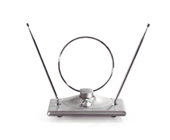 | |
Do I need a new antenna?
Generally, the same antenna that currently provides good quality reception on an analog TV set will also provide good DTV reception, but this is not always the case. The type of antenna you need for digital reception depends on several factors, including how far you are from the transmitting station, where your antenna is located and in which frequency band the stations are that you want to watch. UHF and VHF There are two types of frequency bands: UHF (Channels 14-51) and VHF (Channels 2-13). Most DTV stations use channels in the UHF band, although some are in the VHF band. So you will likely need an antenna that can receive UHF signals, but if any stations in your area broadcast on VHF, then you will need a combination VHF/UHF antenna. Receiving VHF and UHF requires different types of antennas. If your existing antenna is VHF-only, then you will need to replace it. Please note that after June 12, 2009, some stations will be moving to a different frequency band, so you should check whether that is the case in your area before deciding which type of antenna you need. Indoor and outdoor antennas There are several types of antennas ranging from the common indoor “rabbit ears” to large outdoor antennas. While the antenna you are using for analog reception may work satisfactorily for DTV, newer designs may work better in some situations. Outdoor antennas, which are usually mounted on a rooftop, are preferable in areas with difficult reception. The best antenna type for you depends on how far you are from the transmitting station, whether you live in a house or an apartment, and whether there are hills, tall buildings or large trees near your home. Depending on the selected features, antennas can cost anywhere between $10 and $100 (plus the installation charge for an outdoor antenna) and are sold at electronics retailers nationwide. Consumers can find suggestions for appropriate outdoor antennas by entering their street address at www.AntennaWeb.org, a Web site provided by NAB and the Consumer Electronics Association. Using geographical maps and signal strengths, the site’s database predicts which stations are available at a particular location, the type of antenna needed and which direction the antenna needs to be pointed. Positioning your antenna Due to your geographic location or an individual station’s signal strength, there may be some stations that are easier to receive in digital than others. Besides choosing the right type of antenna, you also need to adjust its position and the direction it is pointing to get the best reception. If you are having trouble receiving stations after hooking up a converter box with an indoor antenna, try moving the antenna around and changing its angle. If that doesn’t work, you may need to get a different indoor antenna design or consider changing to an outdoor antenna. In general, mounting an antenna higher gets better reception and an outdoor antenna needs to be pointed carefully in the right direction. Remember to check whether you have the right UHF or combination UHF/VHF antenna for all of the stations you want to watch. Click here for more information about antennas and digital television: |
Resource MenuHome Do I need a new antenna? Helpful tips about antennas and DTV How do I get a converter box coupon? Learn how to apply How do I hook up a converter box? Get tips on installing your box Why is rescanning so important? Learn why you must rescan regularly How can people with disabilities prepare? Helpful resources for these viewers What is low-power television? Find LPTV stations in your area How does DTV affect emergency broadcasting? Stay connected during emergencies How can I recycle my old TV? Find recycling resources near you How can I help others get ready for DTV? Tips on how you can help a neighbor Resources for Presentations |
| © 2008 DTV Transition Coalition | Who We Are | |
 Viewers will still need an antenna to continue watching free, over-the-air television after the DTV transition.
Viewers will still need an antenna to continue watching free, over-the-air television after the DTV transition.